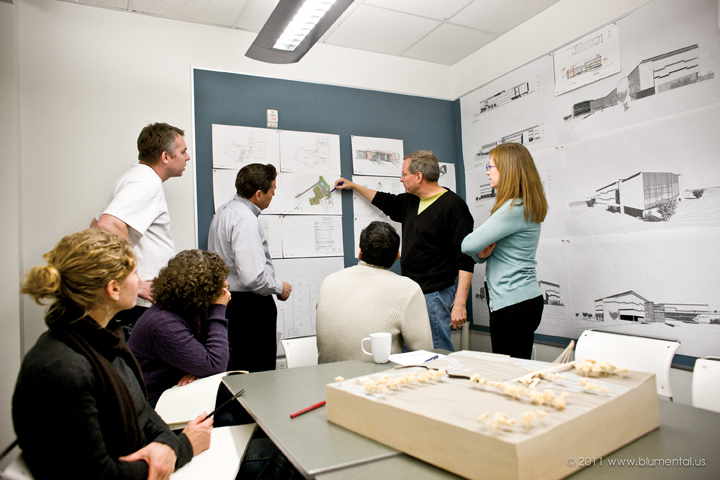At 65 employees, MHTN Architects is one of the largest architecture firms in Utah, which it has been serving from its base in Salt Lake City since 1923. That devotion to service applies not only to the many public and private buildings it has designed throughout the Beehive State, but also to the firm's commitment to the social well-being of the people of Utah.
For example, MHTN worked with the Salt Lake CAP Head Start Program in leading the design and construction of two apartment units for a Head Start classroom serving the city's immigrant population. More recently, MHTN volunteers replaced the landscaping at the Safe Harbor Crisis Center, a women and children's shelter in Kaysville. The firm has outreach programs with Habitat for Humanity, the LDS Church Humanitarian Foundation, Rotary International, Envision Utah, and Kiwanis-Felt Recreation Center.
At the professional level, MHTN gives its employees paid staff time to serve on numerous AIA Utah committees. The firm's CEO, Dennis H. Cecchini, AIA, is president-elect of AIA Utah.
MHTN has also made its mark as a leader in sustainability. It was the first company headquartered in the state to join the U.S. EPA Climate Leaders program, and it was an active participant in Utah's 2010 Clear the Air Challenge, to reduce GHG emissions. The firm recently remodeled its corporate office to LEED-CI Gold standards, the first for any Utah-based design firm.
BEST AEC FIRMS TO WORK FOR 2011 WINNERS
Chapman Construction/Design
EYP Architecture & Engineering
Gensler
HMC Architects
MHTN Architects
The firm is an AIA/CES provider whose professional development program is built around nine core values: design, respect, client service, empowerment, accountability, teamwork, environmental responsibility, technical expertise, and community service.
Look for a more extensive report on MHTN in an upcoming issue of BD+C.
Related Stories
| Nov 3, 2010
Dining center cooks up LEED Platinum rating
Students at Bowling Green State University in Ohio will be eating in a new LEED Platinum multiuse dining center next fall. The 30,000-sf McDonald Dining Center will have a 700-seat main dining room, a quick-service restaurant, retail space, and multiple areas for students to gather inside and out, including a fire pit and several patios—one of them on the rooftop.
| Nov 2, 2010
11 Tips for Breathing New Life into Old Office Spaces
A slowdown in new construction has firms focusing on office reconstruction and interior renovations. Three experts from Hixson Architecture Engineering Interiors offer 11 tips for office renovation success. Tip #1: Check the landscaping.
| Nov 2, 2010
Cypress Siding Helps Nature Center Look its Part
The Trinity River Audubon Center, which sits within a 6,000-acre forest just outside Dallas, utilizes sustainable materials that help the $12.5 million nature center fit its wooded setting and put it on a path to earning LEED Gold.
| Nov 2, 2010
A Look Back at the Navy’s First LEED Gold
Building Design+Construction takes a retrospective tour of a pace-setting LEED project.
| Nov 2, 2010
Wind Power, Windy City-style
Building-integrated wind turbines lend a futuristic look to a parking structure in Chicago’s trendy River North neighborhood. Only time will tell how much power the wind devices will generate.
| Nov 2, 2010
Energy Analysis No Longer a Luxury
Back in the halcyon days of 2006, energy analysis of building design and performance was a luxury. Sure, many forward-thinking AEC firms ran their designs through services such as Autodesk’s Green Building Studio and IES’s Virtual Environment, and some facility managers used Honeywell’s Energy Manager and other monitoring software. Today, however, knowing exactly how much energy your building will produce and use is survival of the fittest as energy costs and green design requirements demand precision.
| Nov 2, 2010
Yudelson: ‘If It Doesn’t Perform, It Can’t Be Green’
Jerry Yudelson, prolific author and veteran green building expert, challenges Building Teams to think big when it comes to controlling energy use and reducing carbon emissions in buildings.
| Nov 2, 2010
Historic changes to commercial building energy codes drive energy efficiency, emissions reductions
Revisions to the commercial section of the 2012 International Energy Conservation Code (IECC) represent the largest single-step efficiency increase in the history of the national, model energy. The changes mean that new and renovated buildings constructed in jurisdictions that follow the 2012 IECC will use 30% less energy than those built to current standards.
| Nov 1, 2010
Sustainable, mixed-income housing to revitalize community
The $41 million Arlington Grove mixed-use development in St. Louis is viewed as a major step in revitalizing the community. Developed by McCormack Baron Salazar with KAI Design & Build (architect, MEP, GC), the project will add 112 new and renovated mixed-income rental units (market rate, low-income, and public housing) totaling 162,000 sf, plus 5,000 sf of commercial/retail space.
| Nov 1, 2010
John Pearce: First thing I tell designers: Do your homework!
John Pearce, FAIA, University Architect at Duke University, Durham, N.C., tells BD+C’s Robert Cassidy about the school’s construction plans and sustainability efforts, how to land work at Duke, and why he’s proceeding with caution when it comes to BIM.
















